Last Updated on April 3, 2024
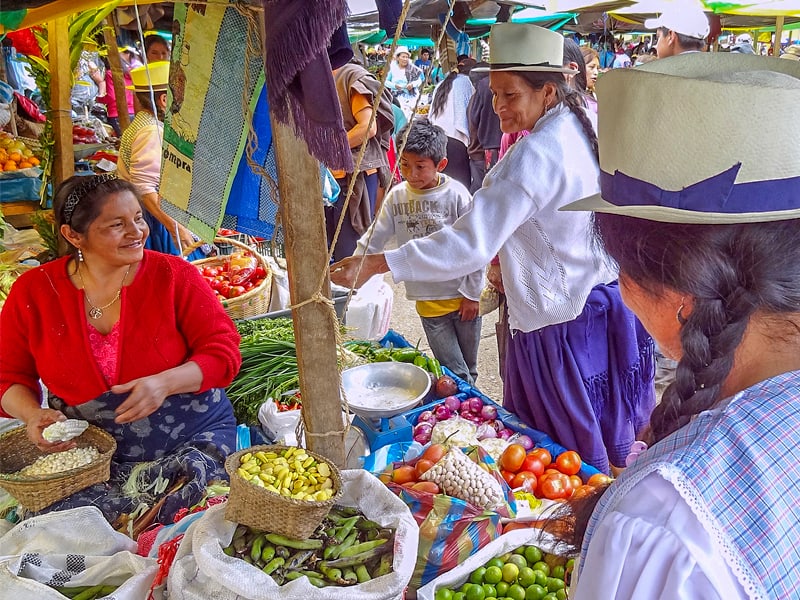
Estimated reading time: 15 minutes
By Jim Ferri
We had heard that Cuenca is unique in Ecuador, a city in the Andes with an ancient culture and many things to do and see.
That’s why my wife Marjorie and I decided to take a side trip to the Andes on our way to the Galapagos. And we’re glad we did.
Cuenca is 8,400 feet up in the Andes in southern Ecuador. It is not easy to get to unless you arrive by air. However, it’s well worth the trip for its wealth of 16th-century Spanish-colonial architecture. But there’s much more to the Cuenca experience than architecture.
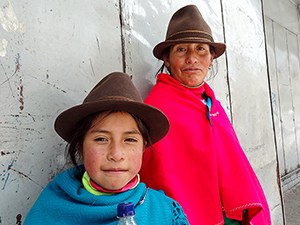
Once you get there, you realize Cuenca is a city paused in time, likely preserved by its location since mountains surround it on four sides. It’s almost magical.
Centuries ago, the Spanish made inroads here, which is why today it’s such a wonderful mix of European and indigenous cultures. The old way of life remains, most evident by the women wearing traditional Panama hats and brightly colored shawls. 8,400 feet up in the Andes in southern Ecuador, we didn’t expect to find a city with Cuenca’s charisma.
Spend some time here, and you’ll understand why it’s a UNESCO World Heritage Site. Luckily, tourists haven’t yet overrun it, which is one of the likely reasons it attracts such a large American expat population.
Table of contents
- The Mansión Alcázar
- A Wonderful Dinner
- Oner of the Things to Do in Cuenca – Visit the Ecuagenera Orchid Farm
- Casa Museo de la Makana
- The Market at Gualaceo
- Chordeleg’s Jewelry Shops
- A Mix of French and Spanish-Colonial Styles
- Cuenca’s “Indigenous Section”
- One of the Fun Things to Do in Cuenca: Tour the City’s South Side
- One of the Things to Do in Cuenca – Visit Its Unique Cathedral(s)
- Across the Street
- Museum of Modern Art
- Museo Pumapungo
- Things To Do in Cuenca: Don’t Miss a Hat Museum
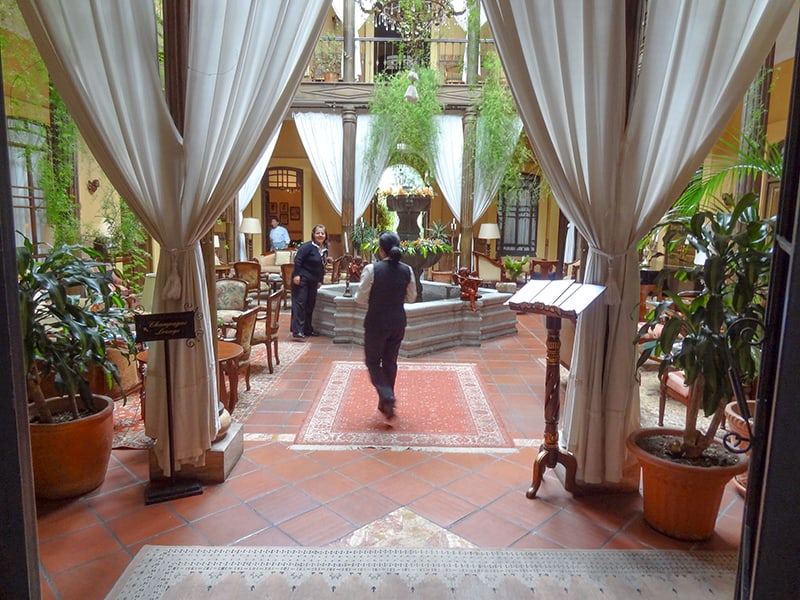
The Mansión Alcázar
Our hotel in Cuenca was the Mansión Alcázar, a 14-room boutique hotel in the heart of the old city. Initially built in the 19th century, it has beautiful colonial architecture with intricate woodwork and colorful tiles. During our stay, we discovered it was the former home of the late Ecuadorian President Luis Cordero.
Most of the Alcázar’s rooms surround the historic building’s former interior courtyard. Now flanking a small fountain are couches and chairs, with a baby grand and harp off to the side.
The hotel is filled with antiques and oozes intimacy and historic elegance. When we arrived, we found our four-poster bed sprinkled with rose petals.
By some quirk of fate, we had the run of the place since we were the only guests that evening.
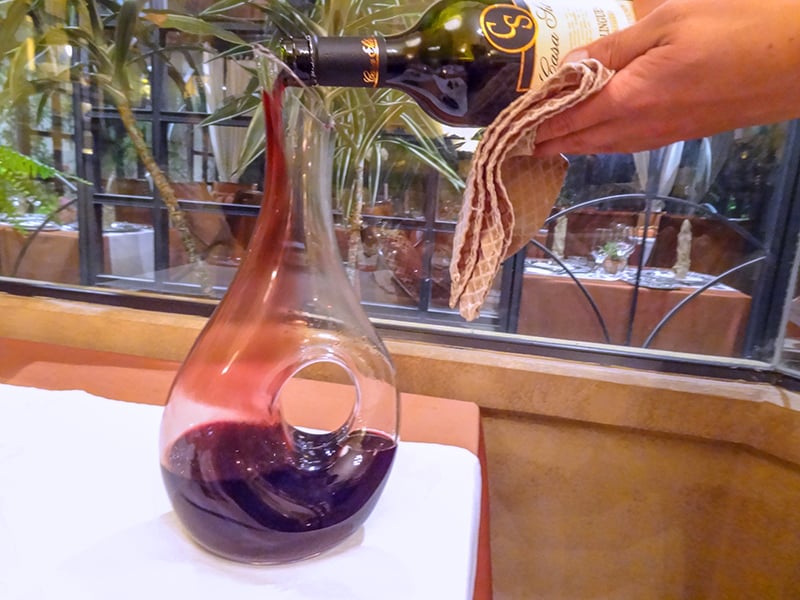
A Wonderful Dinner
Soon after we arrived, I headed out to wander around the area outside the property. When I returned an hour later, I found the lobby courtyard lit only by candles. I felt I had stepped back in time.
Marjorie and I opted to dine at the hotel’s restaurant that evening. After all, what hedonist wouldn’t after the candlelight- and rose-pedal treatment?
The restaurant was in a small glass-enclosed arboretum, and when we sat down, we found a brazier of glowing coals under the table to ward off the slight chill in the evening air. Soon, a maid approached our table and asked if we’d like our bed turned down. She assured us that hot water bottles would be put under the covers.
We were only halfway through perusing the gourmet menu, and already, we felt like the King and Queen of Cuenca. It was a unique and delicious experience.
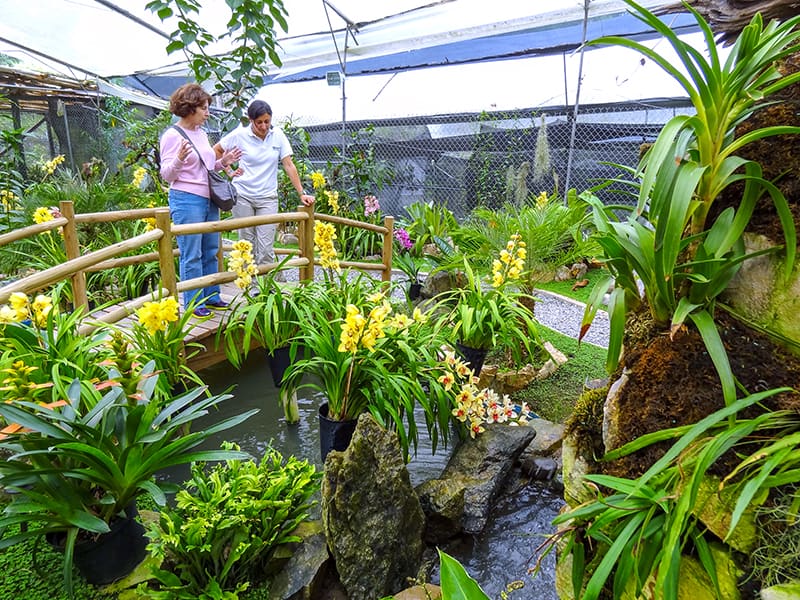
Oner of the Things to Do in Cuenca – Visit the Ecuagenera Orchid Farm
We hired a guide, Cecilia, from Metropolitan Touring, one of Ecuador’s most popular tour companies. The following day, she met us early at our hotel, and we were quickly off to experience more of Cuenca.
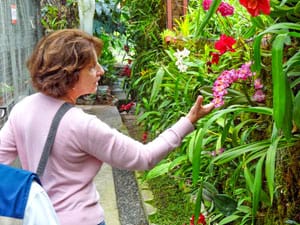
Our first stop was at Ecuagenera, a renowned Ecuadorian orchid farm on the city’s outskirts. It’s about 22 miles (36 km) outside the town, a half-hour drive, and tours cost only a few dollars.
Although I expected it to be a bit boring, it surprisingly turned out to be very interesting.
Ecuador is well-suited for growing orchids with its variety of microclimates from the Andes to the Amazon. There are more than 30,000 species of orchids worldwide, and remarkably, the farm had almost 15,000 of them.
On our private tour, we learned how the farmers were developing new varieties for growers worldwide. It was an interesting hour wandering about admiring and learning about the incredibly beautiful plants as the workers answered our many questions.
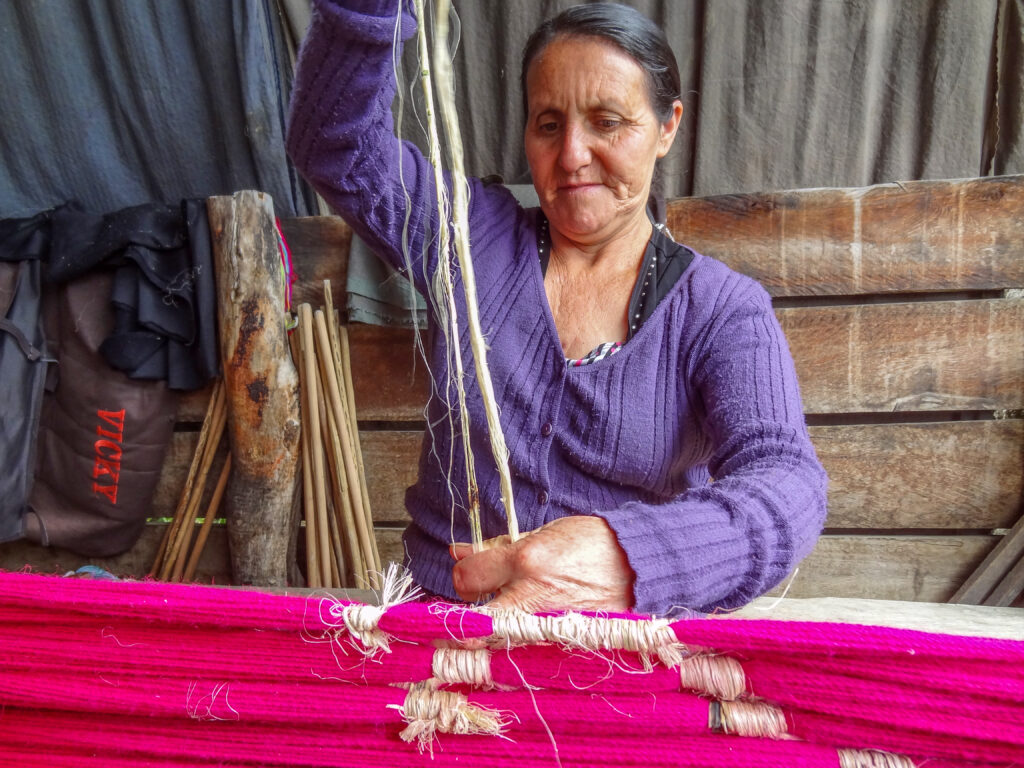
Casa Museo de la Makana
We told Cecilia we wanted to visit an Andean market other than the one at Otavalo, which many have considered a tourist trap.
Cecilia suggested we visit the market at Gualaceo, which is about an hour’s drive from Cuenca through the picturesque countryside. We first stopped at Casa Museo de la Makana, a roadside shop that creates makanas. A makana, we soon learned, is the traditional shawl worn by the indigenous women of the province.
It was an interesting half-hour as we watched weaving on traditional looms and the creation of the clothing. As you would also expect, the house had a small shop in which the weavers sold the fruits of their labors. When we were about to leave, a small tour group arrived. As often happens, many of them skipped the loom demonstration and headed straight for the shop.
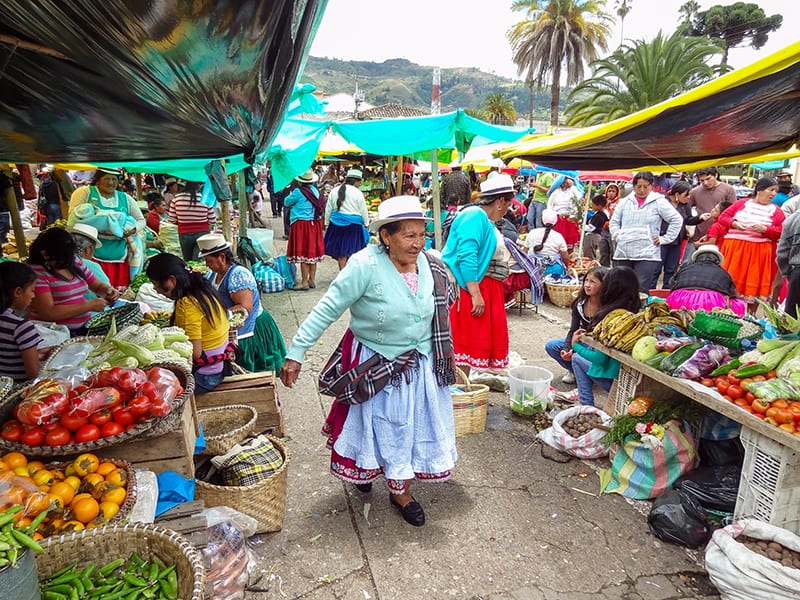
The Market at Gualaceo
The Gualaceo market was typical Ecuadorian, with people from the surrounding villages selling their fruits and vegetables. It was the perfect choice.
Also for sale were handmade products, including woven, embroidered, and leather goods. Scattered about were food stalls selling empanadas, tamales, and grilled and roasted meats. It was a riot of color, with Ecuadorians wearing Panama hats and bright clothing. It was also authentic.
The market is located on Gualaceo’s main square, Plaza Cívica Gualaceo, with Sunday being the most popular market day.
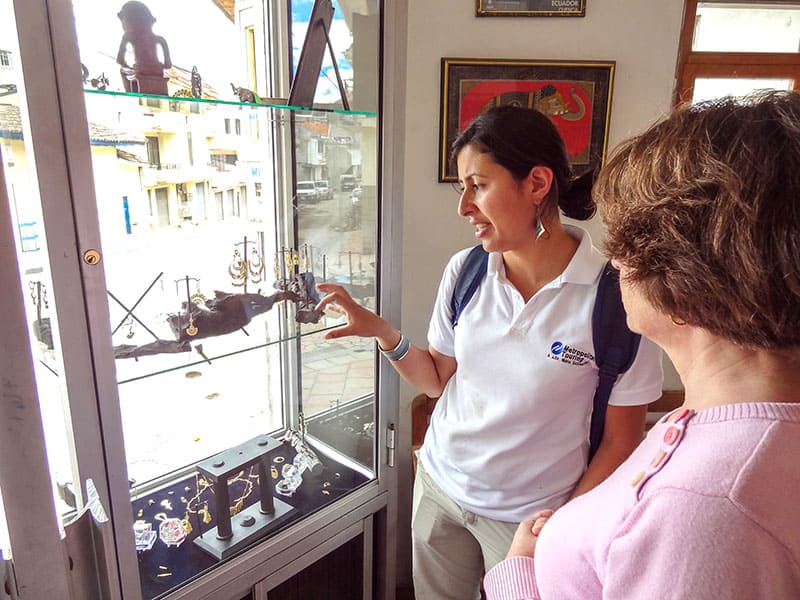
Chordeleg’s Jewelry Shops
When leaving Gualaceo, Cecilia asked if we’d like to visit Chordeleg, about a 10-minute drive away. We were off when she explained that Chordeleg is famous for its silver jewelry and jewelry shops.
Once there, we visited two jewelry shops, but since we were not in a buying mood, we bought nothing. If you’re visiting Chordeleg and want to be closer to the source, you can also see several artisan workshops.
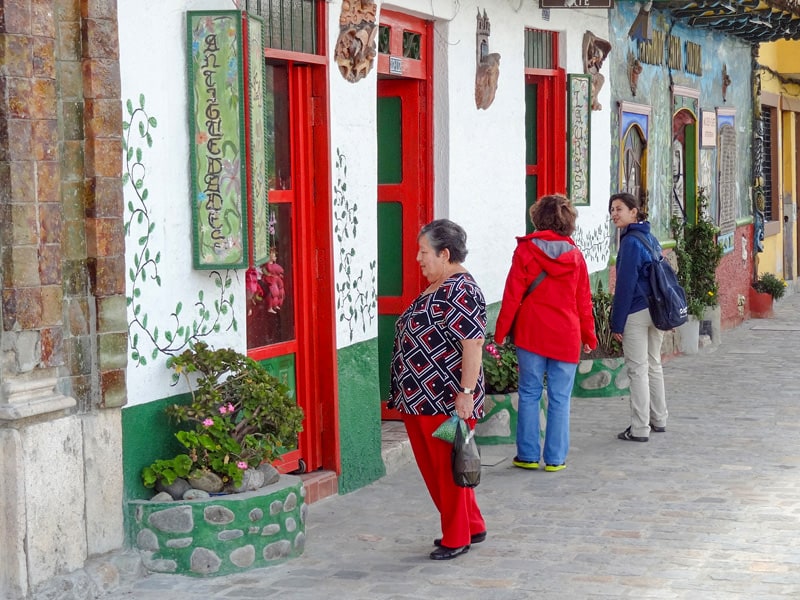
A Mix of French and Spanish-Colonial Styles
Cuenca is a great city for walking since many sights are relatively close. The following day, we set out early with Cecilia to walk around the city.
We soon became intrigued by the city’s beautiful buildings, an unusual combination of French and Spanish-Colonial styles.
Cecilia explained that the French style began to take root in Cuenca about a century ago. At that time, many people ordered merchandise for their homes from France.
But it all came at a price, she explained since there were no roads at the time. Everything from the outside world had to be carried across the 13,000-foot mountain range on the backs of indigenous workers.
The journey took anywhere from 15 days to three months. Even the first motorcar in Cuenca had to be disassembled on the coast and brought in piece by piece.
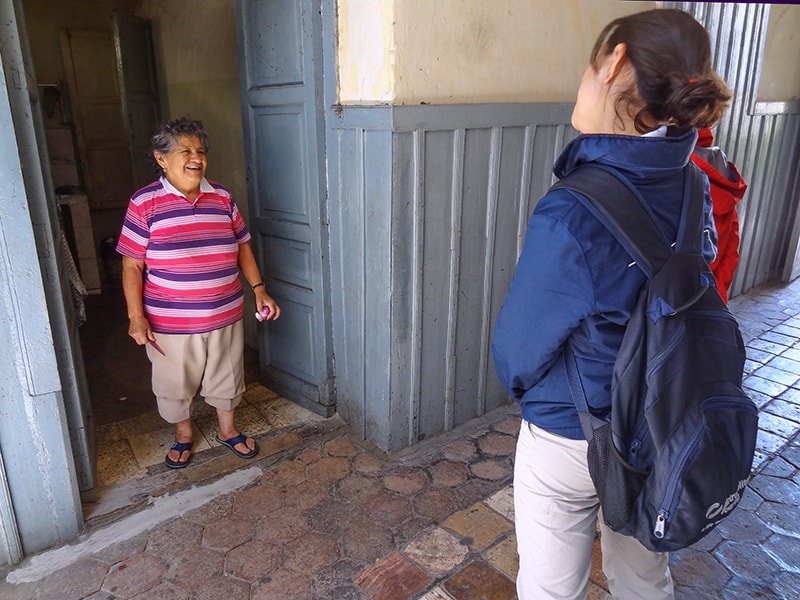
Cuenca’s “Indigenous Section”
Another thing to do in Cuenca is to visit the “indigenous section” of the city, as Cecilia called it. We found buildings only one story tall and completely devoid of windows. From the street, narrow hallways led into little courtyards surrounded by small, windowless rooms in which different families lived.
We poked our heads into one hallway and asked if we might enter. A woman and her teenage grandson quickly invited us in to join them. We soon chatted and learned that the house, inherited from her grandmother, was over 400 years old. She proudly told us of her two children living in New York when she learned we were Americans.
Cecilia later told us that there’s a sizeable Ecuadorian population in New York, so it isn’t unusual for Ecuadorians to migrate there.
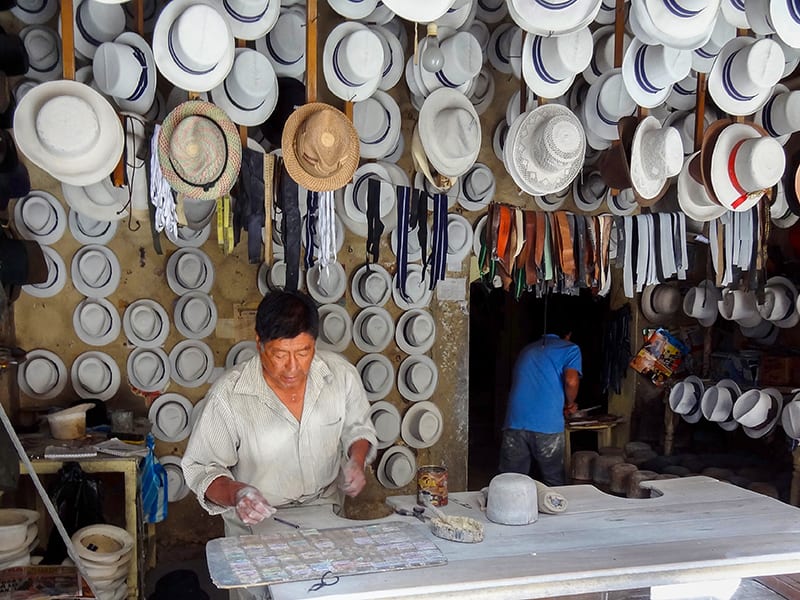
One of the Fun Things to Do in Cuenca: Tour the City’s South Side
We continued walking through the city’s south side, where entire blocks were dedicated to different businesses. We soon found ourselves in the “art area,” with little shops filled with interesting and colorful crafts.
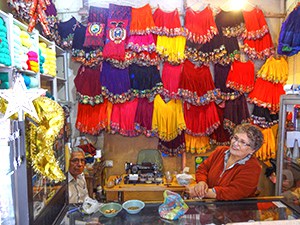
A few minutes later, we walked through the “barbershop area.” Then, it was on to the area filled with Panama hat shops, which catered only to the locals. Soon after, we were in the “embroidery area.”
We stopped in a little embroidery shop and watched the woman and her husband embroider various clothing. One of the things she was most proud of and happily showed us was her embroidery on children’s clothes. She creates them for the Pase del Niño Viajero, the children’s traveling Christmas-Eve pageant, considered the best in Ecuador.
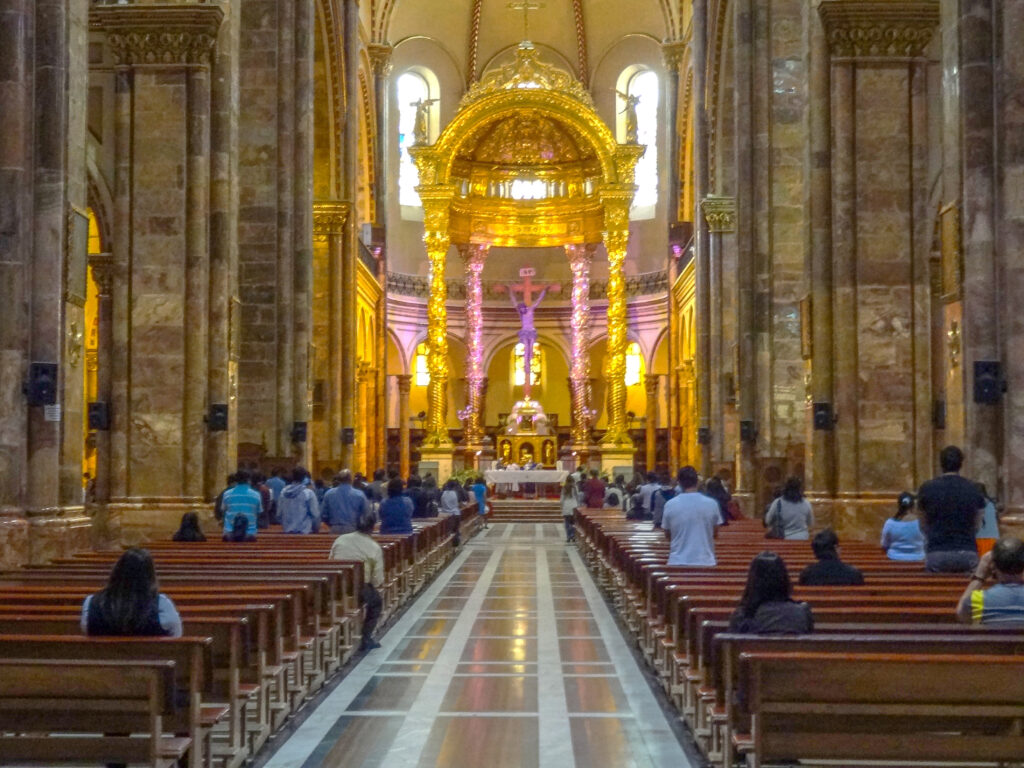
One of the Things to Do in Cuenca – Visit Its Unique Cathedral(s)
Cuenca is a city with two cathedrals. The one with the bright-blue domes seen from all over the city is the “New Cathedral,” the Cathedral of the Immaculate Conception. Its construction began in the late 19th century and was completed in the early 20th century.
An enormous place of worship, it’s the fifth largest in Latin America and home to the largest bell in Ecuador. Along with the cathedral’s smaller bells, it chimes throughout the day.
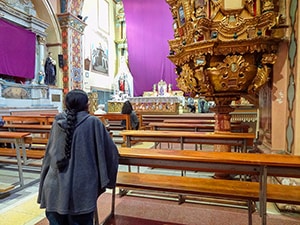
What we found most interesting, however, was the inside of the cathedral. We looked around and saw how a local artist who created much of the church’s stained glass integrated many local influences into his works.
Over one altar, for example, the Virgin wears a Makana like those worn by women throughout Ecuador. Another panel incorporates the sun and the moon, a nod to the original indigenous people. Still, another depicts native women praying.
Some other panels, which accentuate the Gothic elements of the building, are from Belgium and Germany.
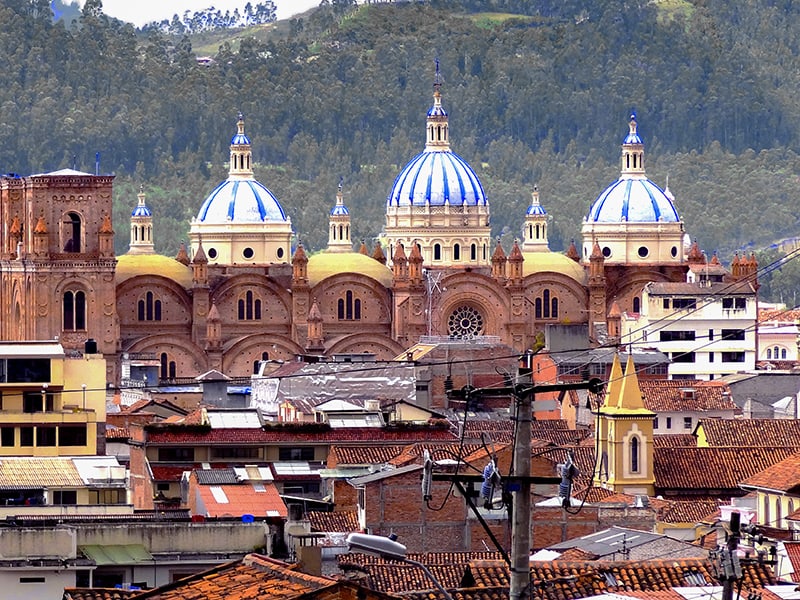
Across the Street
Across the street from the cathedral is the city’s main square, Parque Calderón. It was designed in a French style to stand out from the Spanish architecture around it. Beautifully laid out, it has benches along the walkways, flowers, and trees.
It is strikingly different from other city squares in Cuenca and is a place where you can relax all day. I love this park, which is unique in Ecuador. You’ll probably love it too.
On the far side of the square is the “Old Cathedral“, “Iglesia de el Sagrario,” which is now a religious art museum (open daily; $2 entrance fee for foreigners).
The Old Cathedral is said to have significant historical value since its tower was the reference point for the French Mission that measured the terrestrial meridians. I should note here, however, that the measurements were faulty, resulting in the wrong place being indicated as the equator in Ecuador. You can read about it here: Equador’s Fake Equator.
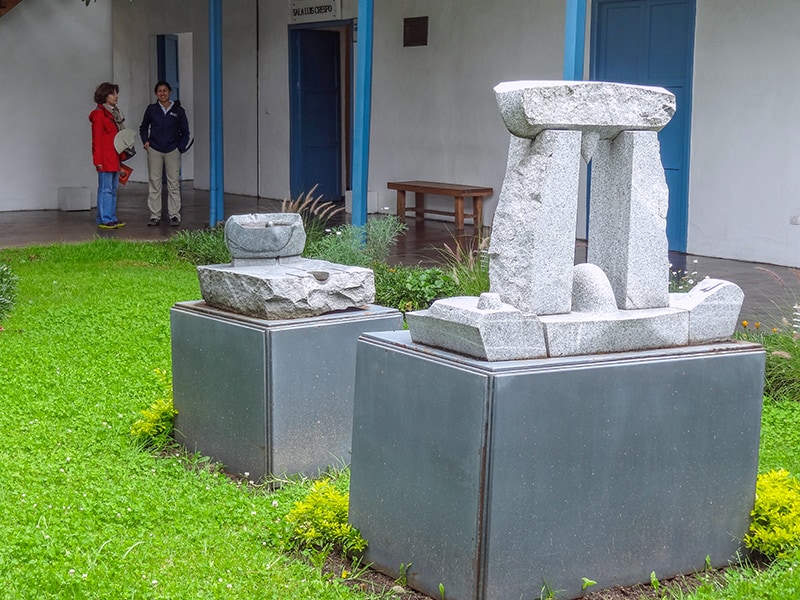
Museum of Modern Art
In the city’s historic center, Cuenca’s 19th-century Temperance House once housed the mentally ill people and those with alcoholic disorders. Today, it houses Cuenca’s Museo Municipal de Arte Moderno (Museum of Modern Art), which showcases Ecuadorian art and photography and works by Latin American artists.
It is also home to a sculpture garden and interactive art space. In its interior are several courtyards with benches, allowing you to relax among the plantings of bushes and trees while enjoying the art displayed in the gardens.
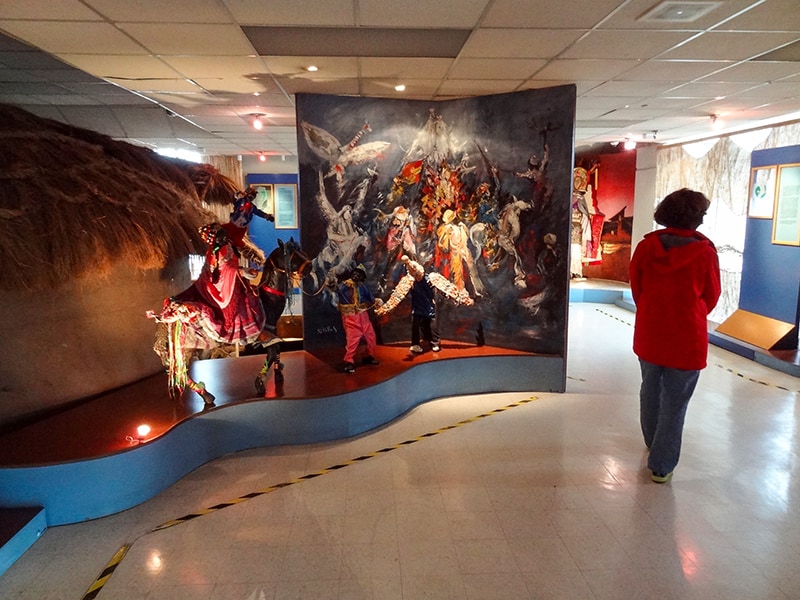
Museo Pumapungo
Cuenca’s Pumapungo Museum, an art and ethnographic museum, is a standout. For us, however, the main interest was not the art (on the first floor) but the ethnographic section on the second. There you’ll find incredible dioramas and other representations of scenes related to the diverse indigenous cultures of Ecuador. It is one of the most significant museums in the entire country.
Another important component of the complex is the outdoor Ancestral Park behind the main building. Among other things here is the site that was most important administrative, military and religious center of the northern part of the Inca Empire. We found the entire complex fascinating. Be sure to visit it; entrance is free.
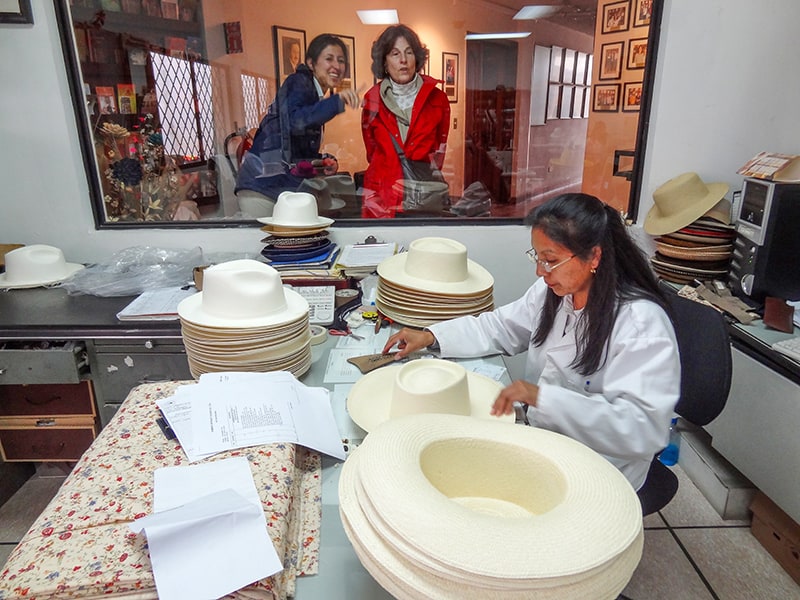
Things To Do in Cuenca: Don’t Miss a Hat Museum
Incongruous as it may seem, the Panama hat was made in Ecuador, not Panama. Supposedly, it picked up the name “Panama” because the word Panama (the port from which it was shipped overseas) was stamped on the box when it arrived.
You’ll see many Panama hats in Cuenca, primarily worn by indigenous Ecuadorians. You’ll also find several hat museums, including the Museo del Sombrero de Paja Toquilla, El Barranco Toquilla Straw Hat Museum, the House of the Hat Municipal Museum, and the Homero Ortega “Magic of the Hat” Museum.
While we’re confident each museum is educational, we enjoyed visiting the “Magic of the Hat” in the Homero Ortega Company’s production facilities. Since the museum is in the company’s production building, you can make your visit interactive by getting directly involved in the production process. Also of interest is that the company is a member of ICOM, an international museum organization associated with UNESCO.
Unfortunately, due to our Galapagos commitment, we could only stay three days in the city. However, there was so many things to see in Cuenca we could easily have stayed longer.
You may also enjoy: Two Surprises in Gualaceo, Ecuador / Top Places To See in Ecuador / Eating Guinea Pig in Ecuador / A Guide to A Galapagos Cruise Vacation / Hire a Tour Guide – It Wil Make an Experience Come to Life

Sadly, Mansion Alcazar, did not survive the Covid pandemic of 2020. A terrible loss to Cuenca.
Thank you Michael. I didn’t know that.
Happy to share that Mansión Alcazar is now open!
Thank you Niels.
Jim
Beautiful presentation of Cuenca. I was born in Guayaquil but when i was a child i used to spend my vacation there, my father was from Cuenca. Now a days i live in New York and most Americans are interested in visit Cuanca. Also considered thr #1 city for retirement for so many advantages Cuenca offers living there. My best regards to all the Cuencanos. Tito, NYC
Thank you Tito. I know there’s a large expat population living there.
Jim
Thanks for such a beautiful words about Cuenca the magic city sorrounded by the Andes mountains.
Victor,
You’re welcome. Cuenca is such a beautiful city.
Jim
Great read on Cuenca. My husband and I are considering investing in property in Cuenca for retirement. We have a decade to go before retirement but I would love some recommendations on a good realtor – where to start. We will be going to Ecuador in January for a month and will be visiting Cuenca for the first time to look around. Any recommendations? Btw, my parents are from Guayaquil I was born and raised in New York but often traveled to Ecuador to visit family.
Hi Vivian,
I don’t know of any. I suggest you be be in contact with teh tourist office in Cuenca. They should be able to provide you with that info.
Jim
Mansión Alcazar is opened again, with a new administration. You can come to Cuenca, and enjoy this beautiful place again.
Thank you again, Angelica.
Jim
Mansion Alcazar survives, is open and providing amazing experiences
Thank you Mateo!
Jim
Mansión Alcazar Reopened on July 2021
Thank you Cornelio.
Jim
They open again after COVID
Thank you Lucia. I’m glad they reopened.
Jim
It did survive, it’s open to the public.
Thank you Teddy. I’m really glad it survived.
Jim
Dear Jim, I want to thanks for this article, it shows our magical city, and it’s contrasts!
My name in Angelica Leon, I’m the director of the tourism board in Cuenca.
It will be a pleasure to have you in Cuenca again, whenever you want.
Greetings
Thank you very much Angelica. That’s very kind of you.
Jim
Hi
I’ve been to Cuenca & I can’t say how much I was impressed, both by the cites as well as how friendly the people where .. I’m going back the end of this year & stay a few months just to be able to see more of Cuenca.. just for additional info I’m going to rent a entire house thru a very familiar site Very cheap
Hi Barbara,
How I envy you being able to spend a few months in Cuenca. It’s also a great starting point to explore Ecuador.
Jim
Great article. Ecuador is on the top of my short list of places to retire. I’m trying to make up my mind about living near or on the beachfront or in the highlands since both have their attraction.
Curious about something from any Cuenca expats or indigenous Cuencans namely, is altitude sickness common for people moving to Cuenca?
I myself haven’t had too much of a problem except for a few days while climbing in Peru. I anticipate that my wife and son might as they did a little in Colorado’s Front Range.
Cuenca is a mile higher than Denver so it would be good to know what to expect.
Thank you James. Have you thought about contacting the Cuenca tourism office? They should be able to answer your question and also put you in touch with some of the many expats who live there.
Jim